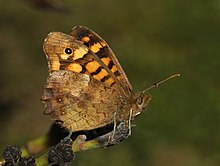Speckled wood butterfly
| Speckled wood | |
|---|---|
 |
|
| Male P. a. tircis | |
 |
|
| Male underside | |
| Scientific classification | |
| Kingdom: | Animalia |
| Phylum: | Arthropoda |
| Class: | Insecta |
| Order: | Lepidoptera |
| Family: | Nymphalidae |
| Genus: | Pararge |
| Species: | P. aegeria |
| Binomial name | |
|
Pararge aegeria (Linnaeus, 1758) |
|
The speckled wood (Pararge aegeria) is a butterfly found in and on the borders of woodland areas throughout much of the Palearctic ecozone. The species is subdivided into multiple subspecies, including Pararge aegeria aegeria,Pararge aegeria tircis, Pararge aegeria oblita, and Pararge aegeria insula. The color of this butterfly varies between subspecies. The existence of these subspecies is due to variation in morphology down a gradient corresponding to a geographic cline. The background of the wings ranges from brown to orange, and the spots are either pale yellow, white, cream, or a tawny orange. The speckled wood feeds on a variety of grass species. The males of this species exhibit two types of mate locating behaviors: territorial defense and patrolling. The proportion of males exhibiting these two strategies changes based on ecological conditions. The monandrous female must choose which type of male can help her reproduce successfully. Her decision is heavily influenced by environmental conditions.
The speckled wood belongs to the genus Pararge, which compromises three species: Pararge aegeria, Pararge xiphia, and Pararge xiphioides. Pararge xiphioides occurs on the Canary Islands. Pararge xiphia occurs on the Atlantic island of Madeira. Molecular studies suggest that the African and Madeiran populations are closely related and distinct from European populations of both subspecies, suggesting that Madeira was colonized from Africa and that the African population has a long history of isolation from European populations. Furthermore, the species Pararge aegeria compromises four subspecies: Pararge aegeria aegeria, Pararge aegeria tircis,Pararge aegeria oblita, and Pararge aegeria insula. These subspecies stem form the fact that the speckled wood butterfly exhibits a cline across their range. This butterfly varies morphologically down the 700 km cline, resulting in the different subspecies corresponding to geographical areas.
The average wingspan of both males and females is 5.1 cm (2 in), although males tend to be slightly smaller than females. Furthermore, males possess a row of grayish-brown scent scales of their forewings that is absent in the females. Females have brighter and more distinct markings than males. The subspecies P. a. tircis is brown with pale yellow or cream spots and darker upperwing eyespots. The subspecies P. a. aegeria has a more orange background and the hindwing underside eyespots are reddish brown rather than black or dark gray. The two forms gradually intergrade into each other. Subspecies P. a. oblita is a darker brown, often approaching black with white rather than cream spots. The underside of its hindwings has a marginal pale purple band and a row of conspicuous white spots. The spots of subspecies P. a. insula are a tawny orange rather than a cream color. The underside of the forewings has patches of pale orange, and the underside of the hindwing has a purple-tinged band. Although there is considerable variation with each subspecies, identification of the different subspecies is manageable.
...
Wikipedia
